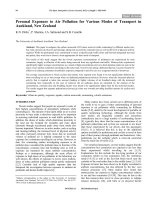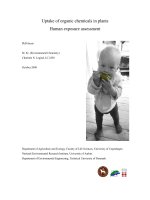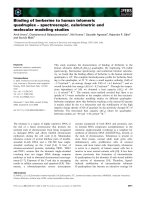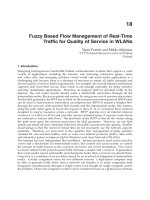Human exposure assessment diet dec 13 compatibility mode
Bạn đang xem bản rút gọn của tài liệu. Xem và tải ngay bản đầy đủ của tài liệu tại đây (140.33 KB, 6 trang )
1
Dr. Len Ritter
RISK ASSESSMENT OF RISK ASSESSMENT OF
EXPOSURE TO PESTICIDE EXPOSURE TO PESTICIDE
RESIDUES IN THE DIETRESIDUES IN THE DIET
Executive Directo
r
Canadian Network of Toxicology Centres
and
Professor
School of Environmental Sciences
University of Guelph
Guelph, Ontario, Canada
Ph. 519-824-4120 x 52980, Fax. 519-837-3861
Email:
How do you Estimate Exposure How do you Estimate Exposure
Through the Dietary Intake of Through the Dietary Intake of
Pesticide Residues ?Pesticide Residues ?
The dietary intake of a pesticide residue in a given
commodity is generally obtained by performing the
following calculation (deterministic):
Pesticide residue level (e.g., MRL)
X
Amount of that commodity
consumed
How are Pesticide Residue How are Pesticide Residue
Levels Estimated ?Levels Estimated ?
• The MRL represents the maximum concentration
ftiidid( d /k)tht
MRL = Maximum Residue Limit
o
f
a pes
ti
c
id
e res
id
ue
(
expresse
d
as mg
/k
g
)
th
a
t
the Codex Alimentarius Commission (CAC)
recommends be legally present in food and
animal feeds
• The MRL is a very conservative estimate of the
potential exposure to the pesticide residue as the
actual levels found in most foods are well below
the corresponding MRLs
MRLMRL
• In the case where a resulting MRL is at or below the
limit of determination/limit of detection (LOD) of the
analytical method, the MRL is set at or about the LOD
and an asterisk
(
*
)
is
p
laced after the MRL in the
() p
Codex Alimentarius
How is Food Consumption How is Food Consumption
Estimated ? Estimated ?
• The WHO uses data from:
- Global Environment Monitoring System (GEMS) –
Food Contamination Monitoring and Assessment
P
P
rogram
- Five regional diets based on the Food and
Agriculture Organization of the United Nations
Average daily food consumption values are used in predicting
pesticide residue intake for long-term hazards NOT day to day food
consumption as there is high variability over a short period of time
How do you Estimate the Dietary How do you Estimate the Dietary
Intake of Pesticide Residues ?Intake of Pesticide Residues ?
TMDI = Theoretical Maximum Daily Intake
The TMDI = Σ (MRL x F)
Where:
MRL = Maximum Residue Limit for a given food
commodity
F = Regional consumption of that food commodity per
person
2
Calculating a TMDICalculating a TMDI
The calculation for determining the TMDI
may be simple for pesticides with residues
in only one food commodity
Calculating a TMDICalculating a TMDI
This pesticide has only been detected in wheat with a
MRL f
0
001
/k Th
Example: Pesticide “A”
MRL
o
f
0
.
001
mg
/k
g.
Th
e average person consumes
approximately 0.2 kg/day of wheat in their diet.
Therefore, TMDI = MRL
Wheat
x Wheat consumption
= 0.001 mg/kg x 0.2 kg/day
= 0.0002 mg/day
Calculating a TMDICalculating a TMDI
However, some pesticide residues may be
present in many foods, and the calculation
may be more complex for pesticides with
residues in many food commodities and
residues
in
many
food
commodities
and
drinking water
++
Calculating a TMDICalculating a TMDI
This
p
esticide has been detected in wheat
,
p
otatoes
Example: Pesticide “B”
p,p
and eggs, with all commodities having a MRL of 0.001
mg/kg. The average person consumes approximately
0.2 kg/day of wheat, 0.5 kg/day of potatoes and 0.1
kg/day of eggs in their diet.
Therefore,
TMDI = Σ
(
MRL x Food consum
p
tion
)
Calculating a TMDICalculating a TMDI
(p)
= (MRL
Wheat
x Wheat consumption) + (MRL
Potatoes
x Potato
consumption) + (MRL
Eggs
x Egg consumption)
= (0.001 mg/kg x 0.2 kg/day) + (0.001 mg/kg x 0.5 kg/day) +
(0.001 mg/kg x 0.1 kg/day)
= 0.0002 mg/day + 0.0005 mg/day + 0.0001 mg/day
= 0.0008 mg/day
The IEDI The IEDI –– “The refined TMDI”“The refined TMDI”
The International Estimated Daily Intake (IEDI)
incorporates correction factors to refine the intake
estimate on the basis of all available information,
providing a best estimate of dietary intake
Factors for refining estimates of residue levels:
- Use of median residue levels from supervised trials, instead
of the maximum
- Consideration of the level of residues found in the edible
portion of foods
- Effects of processing and cooking on residue levels
3
The IEDI The IEDI –– “The refined TMDI”“The refined TMDI”
IEDI = Σ (SMTR x E x P x F)
Where:
STMR = Supervised trials median residue level for a given
food commodity
E = Edible portion factor for that food commodity*
P = Processing factor for that food commodity
F = Regional consumption of that food commodity per
person
* For some commodities, such as bananas, STMR levels may be determined directly from
levels measured in the edible portion
Components of the IEDIComponents of the IEDI
Median Residue Levels from Supervised Trials (STMRs)
- more appropriate starting point for estimating
potential exposure
potential
exposure
- uses the most likely residue level (e.g., median level)
as opposed to the unrealistic maximum residue level
- the STMR value is used by the WHO to calculate
the IEDI whenever a STMR has been determined by
the Joint FAO/WHO Meeting on Pesticide Residues
(JMPR)
Components of the IEDIComponents of the IEDI
Edible Portion Factor
- MRL are established for residues present in the whole
commodity, including inedible portions, but for commodities
with inedible peel the outer inedible portion of the commodity
with
inedible
peel
,
the
outer
inedible
portion
of
the
commodity
will often contain most of the residue
-Residue data, ideally, should quantify the distribution of
residue in the whole and the edible portion of a commodity
- The WHO has recommended that residue data on the edible
portion should be obtained for citrus fruits, bananas,
pineapples, kiwifruits, and other fruits with inedible peel;
cereals; oilseeds; and cucurbits with inedible peel such as
melons
Components of the IEDIComponents of the IEDI
Processing Factor
-Residues on raw commodities are normally
dissipated during storage, transport,
preparation, commercial processing and
cooking
- However, in some cases residues may be concentrated
in processed fractions, resulting in higher levels than in
raw commodities
- Data on the effects of storage, processing and cooking
on residues are not readily available and requires more
work
Components of the IEDIComponents of the IEDI
Processing Factor
- What’s more important to consider with the
processing of food is the potential for producing
metabolites or degradation products of toxicological
concern
- MRLs are not usually established for these
metabolites or degradation products, but these
compounds are of concern in terms human health and
should not be ignored
Components of the IEDIComponents of the IEDI
The Hidden Component – Other Sources
of Residues
- In estimating dietary intake of pesticide residues, consideration
should be given to other known sources of residues other than
simply from food commodities
Food
Sources
Drinking Water
Sources
Residential
Sources
4
NTMDI NTMDI –– A National Level A National Level
ApproachApproach
NTMDI = National Theoretical Maximum Daily Intake
The NTMDI = Σ (MRL x F)
Where:
MRL = Maximum Residue Limit (or National maximum
limit) for a given food commodity
F = National consumption of that food commodity per
person
NTMDI versus the TMDINTMDI versus the TMDI
Unlike the TMDI, the NTMDI incorporates:
- National food consumption data
and
and
- Any available National maximum residue limits
(MRLs) derived from supervised trials
conducted in the country to determine mean
residue levels
The NTMDI provides the basis to better characterize
the potential for exposure for people living in that
country
The NEDI The NEDI –– “The Refined IEDI”“The Refined IEDI”
The National Estimated Daily Intake (NEDI) like the
IEDI, incorporates correction factors to refine the
intake estimate on the basis of all available
intake
estimate
on
the
basis
of
all
available
information. However, in this case the NEDI uses the
available national data to provide a best estimate of
the national dietary intake
NEDI = Σ (SMTR x E x P x F)
Where:
The NEDI The NEDI –– “The Refined IEDI”“The Refined IEDI”
STMR = National supervised trials median residue
level for a given food commodity
E = Edible portion factor for that food commodity*
P = Processing factor for that food commodity
F = National consumption of that food commodity per
person
The NEDI The NEDI –– “The Refined IEDI”“The Refined IEDI”
There are several factors considered in deriving
a NEDI that are not considered in deriving an
IEDI
Proportion of the crop or commodity treated
-
Proportion
of
the
crop
or
commodity
treated
- Proportions of crop or commodity produced
domestically and imported
- National monitoring and surveillance data
-Total national diet (market basket) studies
- Food consumption data, including subgroups of the
population
Summary of Factors for Refining Summary of Factors for Refining
Estimates of Pesticide Residue LevelsEstimates of Pesticide Residue Levels
NEDI and IEDI NEDI Only
5
LongLong Term versus ShortTerm versus Short Term Term
Exposure EstimatesExposure Estimates
Short-term intakes of pesticide residues above an
acute RfD are of more concern than a short-term
intake above a chronic RfD, because toxicity might be
observed after one or only a few exposures
- Unlike chronic exposures, which evaluate overall
average consumption of a food commodity over a
long period of time, acute exposures examine food
consumed at a particular meal or over a period of a
day.
LongLong Term versus ShortTerm versus Short Term Term
Exposure EstimatesExposure Estimates
Example:
- Pesticide “A” has an acute RfD of 0.2 mg/kg bw based
on CNS effects and Pesticide “B” has an chronic ADI of
0
.
2
mg/kg bw based on hematological effects
0
.
2
mg/kg
bw
based
on
hematological
effects
- Both Pesticide “A” and Pesticide “B” only have
registered uses on rice with the same TMDI value of
0.25mg/kg
-It has been found that on average a person consumes
one meal every five days that contains rice
Is this use safe for acute exposures ? Chronic exposures ?
For this example we will consider five days to be a chronic exposure
LongLong Term versus ShortTerm versus Short Term Term
Exposure EstimatesExposure Estimates
0.25
0.3
“A” Acute RfD
0
0.05
0.1
0.15
0.2
012345
Days
TMDI (mg/day)
acute chronic
“B” chronic ADI
LongLong Term versus ShortTerm versus Short Term Term
Exposure EstimatesExposure Estimates
- In estimating the residue level in a food commodity in
an acute exposure assessment, there must be
consideration of the variability in the residue level in the
food
(
e.
g
.
,
difference in residue levels between two
(g,
carrots)
- To address this variability, unlike in a chronic
exposure assessment, the use of median residue
levels is not appropriate and results at the high end of
the residue distribution should be used in an acute
exposure assessment
LongLong Term versus ShortTerm versus Short Term Term
Exposure EstimatesExposure Estimates
- The need to consider the consumption of a number of
food commodities to determine the total exposure to a
particular pesticide residue is not generally relevant in
an acute ex
p
osure situation
p
- It is considered unlikely that an individual will
consume two different food commodities in large
quantities within a short period of time and that those
food commodities will contain the same pesticide at its
MRL
LongLong Term versus ShortTerm versus Short Term Term
Exposure EstimatesExposure Estimates
- Therefore, the calculation of an acute exposure can
generally be based on the consumption of a large
portion of a single commodity
H h hi h id lik l t b f d i
-
H
owever, w
h
en
hi
g
h
res
id
ues are
lik
e
l
y
t
o
b
e
f
oun
d
i
n
more than one commodity it may be necessary to
estimate the total intake
- In such cases, it is still inappropriate to sum the
intake derived from the intake of the individual
commodities and more sophisticated models that can
incorporate the probability of selecting foods with
different residue levels should be used
6
Thank YouThank You
![chương 13 Rui ro va loi nhuan [Compatibility Mode]](https://media.store123doc.com/images/document/13/y/xh/medium_RpdpAoiSgh.jpg)
![RADIOGRAPHIC TESTING NDT – CHUP ANH PHONG XA [compatibility mode]](https://media.store123doc.com/images/document/13/to/wi/medium_wix1380936528.jpg)





![3 principles of testing [compatibility mode]](https://media.store123doc.com/images/document/14/y/sw/medium_5ptPvvn6I4.jpg)

